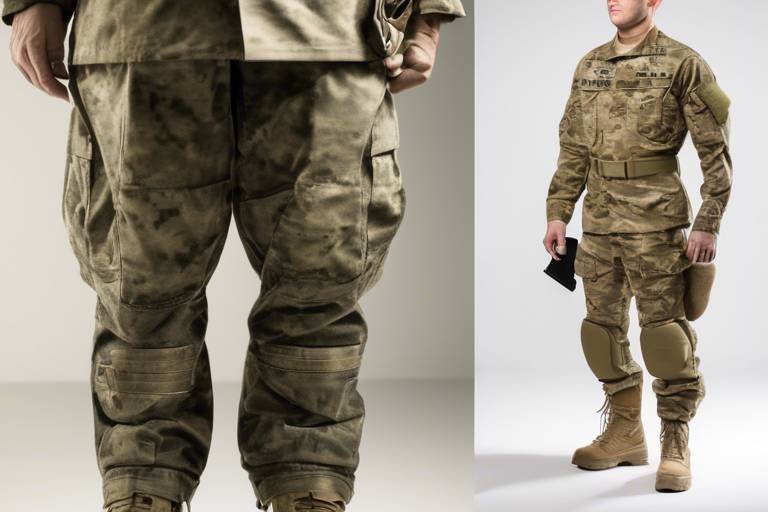How Smart Wearables Aid in Information Dissemination
In an age where information is king, the way we share and consume data has undergone a seismic shift, thanks to the advent of smart wearables. These innovative devices, which seamlessly integrate technology into our daily lives, are not just about fitness tracking or notifications; they are revolutionizing the very fabric of communication and information dissemination. Imagine a world where your wrist can alert you to important emails, your glasses can display real-time updates, and your clothing can monitor your health—all while you go about your day. This article explores the impact of smart wearables on the way information is shared and consumed, highlighting their benefits, challenges, and future potential in various fields.
So, what exactly are smart wearables? In simple terms, they are devices that you can wear, like watches, glasses, or even clothing, that are equipped with advanced technology to help you stay connected and informed. They can track your physical activity, monitor your health metrics, and keep you updated with notifications from your smartphone. The functionalities of these devices vary widely, from smartwatches that display messages and calls to smart clothing embedded with sensors that track your heart rate or body temperature. The types of smart wearables include:
- Smartwatches: These devices offer notifications, health tracking, and even apps.
- Fitness Trackers: Primarily focused on health metrics like steps, heart rate, and calories burned.
- Smart Glasses: These can display information directly in your line of sight, enhancing the user experience.
- Smart Clothing: Garments embedded with sensors that monitor various health indicators.
Understanding these devices is crucial as they become more integrated into our lives, shaping how we interact with the world around us.
One of the most significant impacts of smart wearables is their ability to enhance communication. Imagine receiving a critical message without having to pull out your phone; smart wearables allow for real-time notifications and updates that keep you connected without the hassle. This functionality not only improves personal interactions but also transforms professional communication. With wearables, you can receive alerts during meetings, respond to messages discreetly, and stay informed about important updates without disrupting your workflow.
Incorporating smart wearables in the workplace can streamline communication and enhance productivity. Picture a team where everyone is instantly updated about project changes or urgent tasks without the need for constant meetings. These devices facilitate team collaboration by allowing members to share information quickly and efficiently. For instance, a sales team can receive real-time updates on inventory levels or customer inquiries, enabling them to make informed decisions on the fly. This not only boosts productivity but also fosters a more agile work environment.
Several organizations have successfully implemented smart wearables to improve communication. For example, a major logistics company adopted smartwatches for its delivery personnel, allowing them to receive instant notifications about route changes or customer requests. The result? A significant reduction in delivery times and an increase in customer satisfaction. These success stories illustrate how smart wearables can lead to positive outcomes in various professional settings.
Despite their advantages, the adoption of smart wearables in workplaces comes with challenges. Privacy concerns are paramount; as these devices collect sensitive data, organizations must ensure that personal information is safeguarded. Additionally, the integration of new technology can be met with resistance from employees who may be hesitant to adopt new tools. Addressing these issues is essential for the successful implementation of smart wearables in any organization.
Smart wearables are revolutionizing healthcare by enabling continuous monitoring and data collection. Imagine a world where your doctor can monitor your heart rate, activity levels, and sleep patterns in real-time, allowing for personalized care without the need for constant visits. These devices play a crucial role in patient care, remote monitoring, and health management, empowering individuals to take control of their health and well-being.
As smart wearables collect sensitive data, privacy and security issues arise. The importance of safeguarding personal information cannot be overstated, especially when it comes to health data. Users must be aware of how their information is being used and shared. Companies are taking measures to ensure user safety, implementing encryption and secure data storage practices to protect sensitive information.
The development of regulatory frameworks is crucial for the safe use of smart wearables. Existing regulations must evolve to address the unique challenges posed by these devices. Comprehensive guidelines are needed to protect users from potential misuse of their data, ensuring that privacy is respected while still allowing for innovation in the field.
The future of smart wearables looks promising, with advancements in AI and connectivity on the horizon. Emerging trends such as improved battery life, enhanced health monitoring capabilities, and seamless integration with other technologies could further enhance information dissemination through these devices. As we move forward, the potential for smart wearables to transform our lives is boundless.
Q: What are smart wearables?
A: Smart wearables are devices that integrate technology into clothing or accessories, allowing users to receive and process information seamlessly.
Q: How do smart wearables improve communication?
A: They provide real-time notifications and updates, facilitating instant messaging and alerts that enhance both personal and professional interactions.
Q: What challenges do organizations face when adopting smart wearables?
A: Privacy concerns and technological integration issues are significant challenges that organizations must address.
Q: How are smart wearables used in healthcare?
A: They enable continuous monitoring and data collection, allowing for personalized care and remote health management.
Q: What is the future of smart wearables?
A: The future looks bright with advancements in AI and connectivity, promising further innovations in how we share and consume information.
Understanding Smart Wearables
Smart wearables are the remarkable intersection of technology and personal accessories, transforming the way we interact with information daily. These devices, which can be as subtle as a smartwatch or as advanced as smart glasses, integrate seamlessly into our lives, allowing us to receive and process data without the need for traditional screens. Imagine a world where your wrist not only tells time but also alerts you to important notifications, tracks your health metrics, and even provides navigation assistance. This is the essence of smart wearables, and they come in various forms, each designed to enhance our experience in unique ways.
At their core, smart wearables utilize sensors and connectivity to gather data and communicate with other devices. This connectivity can take many forms, including Bluetooth, Wi-Fi, and even cellular networks. The functionalities of smart wearables can be categorized into a few key types:
- Health Trackers: Devices like fitness bands monitor physical activity, heart rate, and sleep patterns, providing valuable insights into personal health.
- Smartwatches: These multifunctional devices not only tell time but also allow users to receive calls, messages, and notifications directly on their wrists.
- Smart Glasses: With augmented reality capabilities, these glasses provide real-time information overlays, enhancing both personal and professional tasks.
- Wearable Cameras: Devices that capture video and photos hands-free, often used in action sports or for documenting experiences.
The beauty of smart wearables lies in their ability to collect and analyze data in real time. For instance, a fitness tracker doesn’t just count your steps; it interprets your data to suggest personalized workout plans or alert you when you need to move. This level of interaction creates a more engaging user experience, fostering a deeper connection between individuals and their health or productivity goals.
Moreover, the potential for smart wearables extends far beyond personal use. In professional settings, they can facilitate efficient workflows, enhance communication, and even assist in training and development. Imagine a construction worker wearing a smart helmet that provides real-time safety alerts and project updates—this could significantly reduce workplace accidents and improve overall efficiency.
As we delve deeper into the world of smart wearables, it’s essential to recognize both their benefits and challenges. While they offer unprecedented access to information and connectivity, the integration of such technology into our daily lives raises questions about privacy, security, and the digital divide. Understanding these devices is just the beginning; navigating their implications will be crucial as we move forward in this tech-driven era.
Impact on Communication
In today's fast-paced world, communication is everything. With the advent of smart wearables, the way we connect and share information has evolved dramatically. Imagine having the ability to receive real-time updates and notifications right on your wrist or even embedded in your clothing! This seamless integration of technology into our daily lives not only enhances personal interactions but also transforms professional communication.
Smart wearables, such as smartwatches and fitness trackers, allow users to stay connected without the need to constantly check their phones. Picture this: you’re in a meeting, and instead of interrupting the flow of conversation to glance at your phone, you simply receive a discreet vibration on your wrist indicating an important message or alert. This ability to stay informed while remaining engaged in the moment is a game changer.
Moreover, these devices facilitate instant messaging and alerts, making communication more efficient than ever. For instance, during a busy workday, a team member can quickly send a message that pops up on your wearable, allowing for immediate responses without breaking your focus. This not only boosts productivity but also fosters a more collaborative environment. Here are some specific ways smart wearables enhance communication:
- Real-Time Notifications: Stay updated with messages, emails, and calls without the hassle of pulling out your phone.
- Health Monitoring: In healthcare settings, wearables can alert medical staff to patient needs, improving response times.
- Location Tracking: In emergency situations, wearables can provide crucial location data to first responders.
In the workplace, the integration of smart wearables can lead to greater efficiency and effectiveness in communication. Imagine a scenario where team members are equipped with smart glasses that display project updates or critical information without needing to look away from their tasks. This kind of technology not only streamlines communication but also minimizes the risk of errors that can occur when switching focus between devices.
Incorporating smart wearables in the workplace can significantly enhance productivity. For example, companies are using wearables to track employee performance and manage tasks more effectively. Through data collection and analysis, organizations can identify bottlenecks and areas for improvement, leading to better resource allocation and team dynamics.
Furthermore, wearables can facilitate team collaboration by providing platforms for instant feedback and communication. Imagine working on a project where team members can share updates in real time, receiving notifications on their devices that prompt immediate discussions or adjustments. This level of connectivity can lead to innovative solutions and faster project completion.
Several organizations have successfully implemented smart wearables to improve communication. For instance, a tech company introduced smartwatches for its employees, allowing them to receive instant alerts about project deadlines and team meetings. The result? A noticeable increase in on-time project completions and overall employee satisfaction. Another healthcare provider utilized wearable technology to monitor patient vitals remotely, ensuring timely communication between patients and medical staff. These case studies illustrate not only the potential of smart wearables but also the tangible benefits they can bring to various sectors.
Despite their advantages, the adoption of smart wearables in workplaces does come with challenges. Privacy concerns are paramount, as employees may worry about constant monitoring and data collection. Additionally, the integration of these devices into existing systems can pose technological hurdles. Organizations must navigate these challenges carefully to ensure that the benefits of smart wearables outweigh the potential drawbacks.
In conclusion, the impact of smart wearables on communication is profound. They offer a unique blend of convenience and efficiency that can enhance both personal and professional interactions. As we continue to embrace this technology, the future of communication looks brighter than ever.
Wearables in the Workplace
In today's fast-paced work environment, smart wearables are becoming indispensable tools that not only enhance communication but also boost productivity. Imagine a world where your team can seamlessly share updates, track tasks, and monitor performance—all while keeping their hands free. This is the reality that smart wearables bring to the workplace, transforming how we collaborate and interact with technology.
One of the most significant advantages of integrating wearables into the workplace is their ability to provide real-time data and notifications. For instance, smartwatches can alert employees to important messages or reminders without needing to pull out a phone or interrupt their workflow. This kind of instant communication helps maintain focus and efficiency, allowing teams to respond to issues as they arise. In fact, studies have shown that companies utilizing smart wearables report a noticeable increase in employee engagement and satisfaction.
Moreover, wearables can play a crucial role in enhancing team collaboration. With features like voice commands and hands-free operation, employees can easily communicate with colleagues while on the move. For example, a project manager can receive updates about ongoing tasks while attending a meeting, ensuring they are always in the loop. This level of connectivity fosters a culture of transparency and teamwork, where everyone is aligned and informed.
However, the implementation of smart wearables is not without its challenges. Organizations must consider factors such as the cost of devices, employee training, and the integration of wearables with existing systems. Additionally, it’s essential to address any potential resistance from staff who may be hesitant to adopt new technology. To overcome these hurdles, companies can organize workshops and training sessions to demonstrate the benefits and functionalities of these devices.
In conclusion, the integration of smart wearables in the workplace is a game-changer. By facilitating communication and enhancing productivity, these devices empower employees to work more efficiently and collaboratively. As technology continues to evolve, the potential for wearables to reshape our work culture is immense, paving the way for a more connected and engaged workforce.
- What types of wearables are commonly used in the workplace?
Common types include smartwatches, fitness trackers, and augmented reality glasses, each serving different purposes from health monitoring to task management.
- How do wearables improve productivity?
Wearables provide real-time notifications, enhance communication, and enable task tracking, which helps employees stay focused and organized.
- Are there privacy concerns with using smart wearables at work?
Yes, privacy concerns can arise, especially regarding data collection and usage. It’s important for companies to establish clear policies and ensure data protection.
Case Studies of Success
In the rapidly evolving landscape of smart wearables, numerous organizations have embraced these technologies to enhance communication and productivity. One standout example is XYZ Corporation, which integrated smart wristbands for its employees. These wristbands provided real-time alerts for meetings, deadlines, and important updates. As a result, the company reported a 30% increase in team collaboration and a noticeable reduction in missed deadlines. Employees felt more connected and informed, leading to a more engaged workforce.
Another compelling case is that of HealthTech Innovations, a healthcare provider that adopted smart wearables for remote patient monitoring. By equipping patients with health trackers, the organization could continuously collect vital signs and health data. This approach not only improved patient outcomes but also reduced hospital readmissions by 25%. The data collected allowed healthcare professionals to intervene proactively, ensuring patients received timely care.
Moreover, Global Logistics Inc. implemented smart glasses for its warehouse staff. These glasses provided hands-free access to inventory data and navigation assistance within the warehouse. The outcome? A staggering 40% increase in operational efficiency. Employees could focus on their tasks without the distraction of handheld devices, streamlining the entire workflow.
These case studies illustrate that the adoption of smart wearables can lead to significant improvements in communication, efficiency, and overall productivity. However, it's essential to remember that successful implementation requires careful planning and consideration of the specific needs of each organization.
- What are smart wearables? Smart wearables are devices that integrate technology into clothing or accessories, allowing users to receive and process information seamlessly.
- How do smart wearables improve communication? They provide real-time notifications and updates, enhancing personal and professional interactions.
- What challenges do organizations face when implementing smart wearables? Challenges include privacy concerns, technological integration, and user adoption.
- What is the future of smart wearables? The future looks promising with advancements in AI and connectivity, potentially enhancing information dissemination further.
Challenges Faced
While the adoption of smart wearables offers a myriad of benefits, it also presents a set of challenges that cannot be overlooked. One of the most pressing issues is privacy concerns. As these devices collect a significant amount of personal data—from health metrics to location tracking—users often worry about who has access to this information and how it is being used. Imagine wearing a device that not only tracks your steps but also monitors your heart rate and sleep patterns; now, consider the implications if that data fell into the wrong hands. It's a bit like leaving your front door wide open while you're away—inviting trouble without even realizing it.
Another challenge is technological integration. Many organizations struggle to incorporate smart wearables into their existing infrastructure. This can lead to compatibility issues, where devices do not communicate effectively with other systems or software. For instance, a company may invest in state-of-the-art wearables for its employees, but if those devices can't sync with the company's project management tools, the investment may not yield the desired productivity improvements. It's crucial for organizations to ensure that the technology they adopt can seamlessly blend into their current operations.
Furthermore, there's the issue of user acceptance. Not everyone is keen on adopting new technology, especially when it comes to personal health and data privacy. Some individuals may feel uncomfortable wearing devices that constantly monitor their activities, leading to resistance in the workplace. To combat this, organizations need to invest time in educating their employees about the benefits of wearables, fostering a culture of trust and transparency. After all, if employees don't see the value in these devices, they're unlikely to use them effectively.
Lastly, the cost of implementation can be a significant barrier. While the price of smart wearables has decreased over the years, equipping an entire workforce can still represent a substantial investment. Organizations must weigh the potential benefits against the costs, considering factors such as training and ongoing support. To help visualize this, here's a simple table outlining some of the costs associated with implementing smart wearables:
| Cost Element | Estimated Cost |
|---|---|
| Device Purchase | $100 - $500 per device |
| Training and Support | $50 - $200 per employee |
| Software Integration | $1,000 - $10,000 (depending on complexity) |
| Ongoing Maintenance | $500 - $2,000 annually |
In summary, while smart wearables have the potential to revolutionize how we communicate and manage information, organizations must navigate these challenges carefully. By addressing privacy concerns, ensuring technological integration, promoting user acceptance, and managing costs, businesses can harness the full potential of smart wearables, paving the way for a more connected and efficient future.
- What are smart wearables? Smart wearables are electronic devices worn on the body that monitor and collect data about the wearer’s activities and health.
- How do smart wearables enhance communication? They provide real-time notifications, alerts, and updates, facilitating instant messaging and improving personal and professional interactions.
- What are the privacy concerns associated with smart wearables? Users worry about the collection, storage, and potential misuse of their personal data, including health and location information.
- Are there any regulatory frameworks for smart wearables? Yes, there are existing regulations, but comprehensive guidelines are still needed to protect users effectively.
- What future trends can we expect in wearable technology? Advancements in AI, improved connectivity, and enhanced data analytics are on the horizon, promising even greater capabilities for smart wearables.
Wearables in Healthcare
In recent years, smart wearables have emerged as transformative tools in the healthcare sector, revolutionizing the way patients manage their health and how providers deliver care. These devices, which include smartwatches, fitness trackers, and specialized medical wearables, enable continuous monitoring of vital signs and health metrics. Imagine having a personal health assistant right on your wrist, constantly tracking your heart rate, sleep patterns, and even blood oxygen levels! This level of monitoring not only empowers patients to take charge of their health but also provides healthcare professionals with invaluable data to make informed decisions.
One of the most significant advantages of wearables in healthcare is their ability to facilitate remote patient monitoring. With the rise of telemedicine, wearables play a crucial role in allowing healthcare providers to keep tabs on patients from afar. For instance, patients with chronic conditions like diabetes or hypertension can wear devices that send real-time data to their healthcare providers. This means that instead of waiting for a scheduled appointment, doctors can receive alerts about potential issues and intervene proactively. This system is not just about convenience; it can be a matter of life and death.
Moreover, smart wearables contribute to health management by encouraging users to adopt healthier lifestyles. Many devices come equipped with features that track physical activity, monitor dietary habits, and even offer reminders for medication. For example, a smartwatch can vibrate to remind you to stand up and move if you've been sitting for too long, or it can log your water intake to ensure you're staying hydrated. This gamification of health encourages users to set goals and achieve them, making the journey towards better health both engaging and rewarding.
However, the integration of wearables into healthcare is not without its challenges. For instance, the accuracy of data collected by these devices is paramount. If a wearable misreads a user's heart rate or blood pressure, it could lead to unnecessary panic or, conversely, a dangerous underestimation of a health issue. Therefore, ongoing research and development are essential to enhance the reliability of these devices. Additionally, the interoperability of wearables with existing healthcare systems poses another challenge. Ensuring that data from various devices can be seamlessly integrated into electronic health records (EHRs) is crucial for providing comprehensive patient care.
In conclusion, the role of wearables in healthcare is undeniably significant. They not only empower patients to take control of their health but also provide healthcare professionals with critical data to improve patient outcomes. As technology continues to advance and the healthcare landscape evolves, the potential for smart wearables to enhance health management and patient care will only grow.
- What types of health data can wearables track? Wearables can track various health metrics, including heart rate, sleep quality, physical activity levels, and even blood glucose levels in some devices.
- Are wearables accurate? While many wearables provide accurate data, their reliability can vary. It's essential for users to consult healthcare professionals for critical health decisions based on wearable data.
- Can wearables replace traditional medical devices? While wearables offer valuable insights and continuous monitoring, they are not designed to replace traditional medical devices but rather to complement them.
- How do wearables benefit healthcare providers? Wearables allow healthcare providers to monitor patients remotely, leading to timely interventions and better management of chronic conditions.
Privacy and Security Concerns
In today's digital age, where technology is intertwined with our daily lives, the rise of smart wearables has opened up a world of possibilities. However, with great innovation comes great responsibility, particularly concerning privacy and security. These devices, ranging from smartwatches to fitness trackers, continuously gather data about our habits, health, and even our locations. This data, while beneficial for personal insights and health monitoring, raises significant questions about how it is used, stored, and shared.
First and foremost, the sensitive information collected by smart wearables can be a double-edged sword. On one hand, they provide users with valuable insights into their health and lifestyle; on the other hand, they can become a target for hackers and unauthorized access. Imagine wearing a device that tracks your heart rate and sleep patterns, only to find that this information has been leaked or sold to third parties without your consent. It's a frightening thought, isn't it?
Moreover, the lack of standardized regulations across the industry complicates matters further. Each manufacturer may have different policies regarding data collection and sharing. To illustrate this point, consider the following table that highlights some of the key privacy policies from popular wearable brands:
| Brand | Data Collected | Data Sharing Policy |
|---|---|---|
| Fitbit | Heart rate, activity levels, sleep data | Shares data with third-party apps with user consent |
| Apple Watch | Health metrics, location data | Strong focus on user privacy; data not sold to third parties |
| Garmin | Fitness data, GPS location | Shares data with partners; users can opt-out |
This table underscores the importance of understanding what data is being collected and how it is being used. As consumers, we must be vigilant and proactive in reading the privacy policies of our devices. Are we comfortable with the extent of data being shared? Are we aware of our rights regarding our personal information?
Furthermore, the potential for data breaches is another pressing concern. With the increasing sophistication of cyber threats, even the most reputable companies can fall victim to hacking attempts. A breach could expose sensitive health information, leading to identity theft or other malicious activities. Therefore, users must take precautions such as enabling two-factor authentication, regularly updating their devices, and being cautious about which apps they connect to their wearables.
In summary, while smart wearables offer incredible benefits, we cannot overlook the privacy and security concerns that accompany them. As technology continues to evolve, it is crucial for both manufacturers and users to prioritize data protection and remain informed about the potential risks. The future of wearables should not only focus on innovation but also on creating a secure environment for users to thrive.
- What types of data do smart wearables collect? Most smart wearables collect data related to health metrics, activity levels, and sometimes location data.
- How can I protect my data while using smart wearables? Enable two-factor authentication, regularly update your device, and review privacy settings to control data sharing.
- Are there regulations for data privacy in smart wearables? The regulatory landscape is still developing, and it varies by region and manufacturer, so it's essential to read individual privacy policies.
Regulatory Frameworks
The rapid adoption of smart wearables has ignited a pressing need for robust to ensure user safety and data protection. As these devices become more integrated into our daily lives, the potential for misuse of personal information grows, making it essential for governments and organizations to establish clear guidelines. The challenge lies in balancing innovation with the protection of individual rights, which can often feel like walking a tightrope.
Currently, various regions have begun to implement regulations that address privacy and data security concerns surrounding smart wearables. For instance, the General Data Protection Regulation (GDPR) in Europe sets stringent rules on how personal data should be collected, stored, and processed. This regulation mandates that users must give explicit consent before their data can be used, and they have the right to access and delete their information. Such frameworks are vital in fostering trust between users and manufacturers, ensuring that individuals feel secure while using these innovative technologies.
Moreover, in the United States, the Health Insurance Portability and Accountability Act (HIPAA) provides guidelines specifically for healthcare-related wearables, ensuring that sensitive health information is handled with the utmost care. As smart wearables increasingly play a role in health monitoring and data collection, regulations like HIPAA become crucial in safeguarding patient privacy.
Despite these existing regulations, there remains a significant gap in comprehensive guidelines that encompass all aspects of smart wearables. For instance, many manufacturers still lack clear protocols for data sharing and user privacy, which can lead to potential breaches. Thus, it's imperative for stakeholders, including tech companies, healthcare providers, and regulatory bodies, to collaborate and develop a cohesive framework that addresses these challenges.
In summary, the evolution of regulatory frameworks surrounding smart wearables is an ongoing process that requires constant attention and adaptation. As technology advances, so must our approaches to regulation, ensuring that users are protected while still benefiting from the incredible potential these devices offer. The future will likely see more harmonized regulations across different jurisdictions, promoting not only innovation but also consumer trust.
- What are smart wearables?
Smart wearables are devices that combine technology with clothing or accessories, allowing users to receive and process information seamlessly. - Why are regulatory frameworks important for smart wearables?
They protect users' privacy and ensure that personal data is handled responsibly, fostering trust between consumers and manufacturers. - What regulations exist for smart wearables?
Regulations such as GDPR in Europe and HIPAA in the U.S. establish guidelines for data protection and privacy in the context of smart wearables. - How can users ensure their data is safe?
Users should look for devices that comply with existing regulations and offer transparent data handling policies.
Future Trends in Wearable Technology
The realm of wearable technology is on the brink of an exciting evolution, driven by rapid advancements in artificial intelligence (AI), connectivity, and user-centric design. As we look ahead, several key trends are poised to redefine how we interact with these devices and the information they provide. Imagine a world where your wearable not only tracks your fitness but also predicts your health needs and communicates seamlessly with your other tech gadgets. This future is closer than you think!
One of the most significant trends is the integration of AI and machine learning. These technologies will enable wearables to analyze data in real-time, offering personalized insights that can enhance user experience. For instance, your smartwatch could learn your daily habits and suggest optimal times for exercise or remind you to take breaks based on your stress levels. The ability to deliver such tailored information could transform personal health management into a more proactive approach.
Moreover, the rise of 5G connectivity will enhance the capabilities of wearables. With faster data transfer rates and reduced latency, wearables will be able to communicate with other devices and the cloud almost instantaneously. This means that your wearable could stream real-time health data to your doctor, allowing for timely interventions and better patient care. Imagine being able to share your heart rate or glucose levels with your healthcare provider without waiting for your next appointment!
Another trend to watch is the focus on interoperability. As consumers increasingly adopt multiple smart devices, the demand for seamless communication between these devices will grow. Future wearables will likely be designed to work harmoniously with other technologies, such as smart home devices and mobile apps. This interconnectedness could create a holistic ecosystem where all your devices collaborate to provide you with a cohesive experience, whether it's managing your home environment or tracking your health metrics.
Additionally, the push for sustainability in technology will influence wearable design. Manufacturers are beginning to recognize the environmental impact of tech waste, leading to innovations in eco-friendly materials and energy-efficient designs. Future wearables may utilize biodegradable materials and feature energy-harvesting capabilities, such as solar charging, reducing their carbon footprint while still delivering high performance.
Lastly, as wearables become more embedded in our daily lives, the importance of privacy and security will continue to rise. As these devices collect vast amounts of personal data, ensuring that this information is protected will be paramount. Future wearables will likely incorporate advanced encryption methods and user-controlled privacy settings, empowering users to manage their data securely.
In summary, the future of wearable technology is not just about tracking steps or heart rates; it's about creating a personalized, interconnected, and secure experience that enhances our lives. As these trends unfold, we can expect a significant shift in how we perceive and utilize wearable devices, making them indispensable tools in our daily routines.
- What are smart wearables? Smart wearables are devices that integrate technology into clothing or accessories, allowing users to receive and process information seamlessly.
- How will AI change wearables? AI will enable wearables to analyze data in real-time, offering personalized insights and recommendations based on user habits.
- What role does 5G play in wearables? 5G will enhance the connectivity of wearables, allowing for faster data transfer and real-time communication with other devices.
- How important is sustainability in future wearables? Sustainability will be crucial, with manufacturers focusing on eco-friendly materials and energy-efficient designs to reduce environmental impact.
- What privacy measures will be implemented in wearables? Future wearables will likely include advanced encryption and user-controlled privacy settings to protect personal data.
Frequently Asked Questions
- What are smart wearables?
Smart wearables are innovative devices that blend technology into clothing or accessories, allowing users to effortlessly receive and process information. Think of them as your personal assistant right on your wrist or in your pocket!
- How do smart wearables enhance communication?
These devices enhance communication by providing real-time notifications and updates. Imagine getting instant alerts about messages or calls without having to pull out your phone. It's like having a direct line to your important updates!
- What are the benefits of using wearables in the workplace?
In the workplace, smart wearables can streamline communication and boost productivity. They facilitate team collaboration, help manage tasks, and keep everyone connected, making work feel more like a well-oiled machine.
- Are there any challenges with adopting smart wearables?
Absolutely! While they offer many benefits, challenges like privacy concerns and the need for technological integration can arise. Organizations must navigate these issues to fully leverage the potential of smart wearables.
- How are smart wearables used in healthcare?
Smart wearables are changing the game in healthcare by enabling continuous monitoring and data collection. They play a vital role in patient care, allowing for remote monitoring and better health management, almost like having a doctor by your side 24/7!
- What privacy and security concerns are associated with smart wearables?
Since smart wearables collect sensitive data, privacy and security are major concerns. It's crucial to safeguard personal information, and many manufacturers are implementing measures to ensure user safety.
- Are there regulations for the use of smart wearables?
Yes, the development of regulatory frameworks is essential for the safe use of smart wearables. Existing regulations aim to protect users, but there’s a growing need for comprehensive guidelines to address emerging challenges.
- What does the future hold for wearable technology?
The future of smart wearables looks bright! With advancements in AI and connectivity, we can expect exciting innovations that will further enhance how information is disseminated through these devices.


















